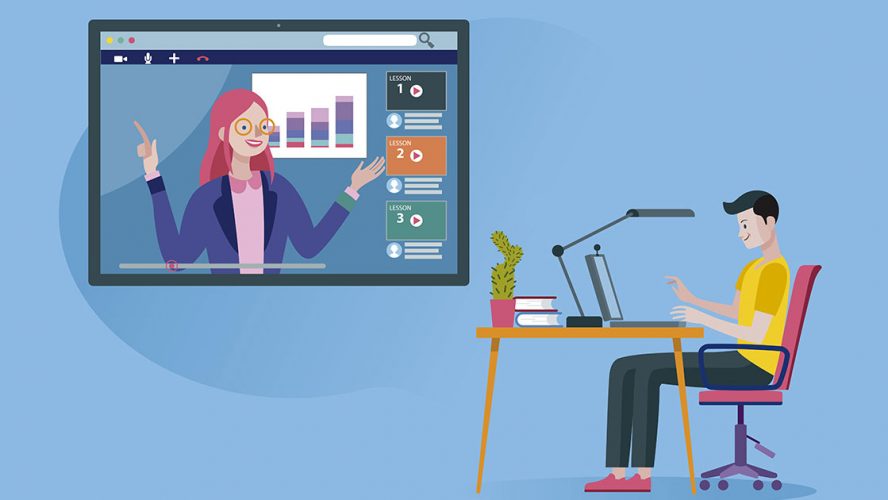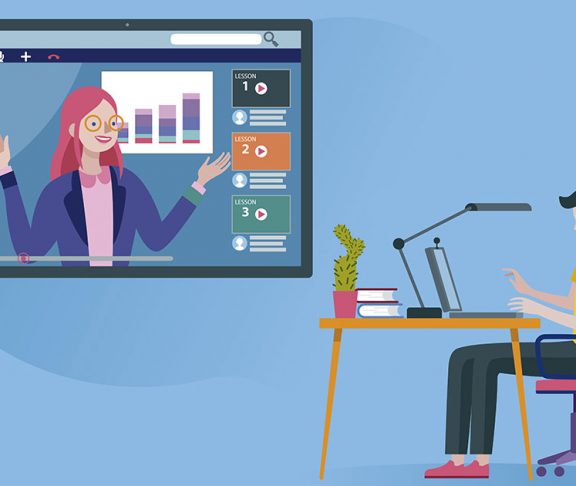By shifting thinking and learning the right lessons from the pandemic, educators can use technology to move forward and personalize learning in creative ways.

Steve Isaacs
Education Program Manager, Epic Games
How can we make sure students receive a personalized hybrid learning experience?
Hybrid learning, while challenging, presents unique opportunities to personalize learning experiences for our students. Some students thrive in an environment that puts much of the learning in the hands of the students, while others clearly need a different level of support.
As long as we remain cognizant of individual needs, we can do a better job of meeting students where they are and creating learning paths that honor the differences. In doing so, we can leverage student’s strengths while recognizing the need for different levels of support.
Providing choice in learning can allow students to follow a learning path that is meaningful to them. At the same time, it is important to acknowledge that some students require much greater structure. Most importantly, we need to move away from a one-size-fits-all approach to learning and find a way to reach all students.
Where do you see education technology heading post-pandemic?
We have learned a lot during the pandemic about challenges with regards to educational technology. Access and equity are huge issues that were exemplified during the pandemic. At the same time, we made some strides in providing support.
Many school districts provided devices for at-home use, as well as internet access where needed. As a result, I believe we better understand the importance of ensuring everyone has access to the tools they need at home and at school. My hope for the future (and sooner the better) is for us to move toward the use of virtual machines as an edtech solution. Schools have invested a lot of money in 1:1 devices, which are great for what they do well, but at the same time are very limited.
What is the biggest trend you have seen in the education technology space during the pandemic?
Educators gained a keen awareness of the importance of engaging students in meaningful ways during the pandemic. Teaching remotely didn’t work by lecturing to a video camera to a group of students who could easily be distracted at home. Educators quickly pivoted and began to take risks in order to keep their students involved in the learning.
In many cases, this was the time that educators decided to try innovative approaches, including game-based learning; providing opportunities for students to create content using a tool of their choice. Educators truly embraced the idea of finding ways to honor student choice in terms of learning. It also became very clear which students required additional support, and teachers had to find ways to ensure these students were not lost in the shuffle. This was probably the most challenging part, and hopefully the area where we learned the most about the importance of meeting the needs of all students.
How has technology helped empower the education space to most effectively elevate classroom engagement, foster collaboration, encourage creativity, and increase student comprehension and performance?
It is crucial that we move away from content consumption to content creation. This requires educators to provide students with choices in terms of how they demonstrate their learning.
Sandbox environments like Minecraft and Fortnite Creative allow for students to collaborate in a virtual space to create anything they can imagine. These can be very powerful tools for students to create in an environment where they already feel comfortable. The collaborative nature is organic in these environments, and as long as educators are clear about the learning objectives and outcomes, students can thrive in such environments.
Beyond that, we have made great strides in the ability to collaborate on documents in real time and, as we have all become comfortable living in a zoom-based world, we have been able to utilize features like breakout rooms to create remote collaborative spaces. These are all valuable approaches as long as educators assume a new role of facilitating the process and guiding students in their learning.

Dan Cavalli
Chief Sales Officer, Flinn Scientific
How can we make sure students receive a personalized hybrid learning experience?
Personalized learning is no different than marketing to the proper persona — in this case, teachers are educating the individual student. The seven learning styles are the personas and the instructional material is the messaging to those students to gauge their interest in the content, determine the type of instruction required to obtain their understanding of the materials, and deliver it in context.
Where do you see education technology heading post-pandemic?
Technology will continue to reduce the achievement gap of students and provide applications to support instruction. As such, edtech companies need to align with progressive thinking pedagogy and professional learning to offer educators open forums to ideate successes. The flexibility technology-enabled instruction can provide will help educators support individualized instruction across the various modalities of learning.
What is the biggest trend you have seen in the education technology space during the pandemic?
Small, innovative technology companies have stepped up to address student engagement, hybrid collaboration, and various learning styles. They adjusted the delivery of their content to meet the needs of educators during remote and hybrid learning, and this delivery will remain post-pandemic as students now have more access to technology.
How has technology helped empower the education space to most effectively elevate classroom engagement, foster collaboration, encourage creativity, and increase student comprehension and performance?
Technology in the hands of great teachers has allowed them to open new worlds for students. In our own work, we have seen educators videotape lab experiments so students can experience a lab at home, and we have seen educators bring students together virtually for online STEM competitions. By educators embracing a more blended learning model, where students consume content out of class and then come together for more robust discussions, in many cases, students have taken more ownership of their learning, which is a valuable 21st-century skill.

John Wheeler
How can we make sure students receive a personalized hybrid learning experience?
Utilizing digital solutions that allow for student engagement through real and meaningful work — and that provide a look into students’ thinking behind that work — are extremely valuable in helping educators deliver personalized learning, whether that learning is taking place remotely or in person. Providing students the tech-enabled opportunities that engage them in the learning process and allow them to be active participants also helps them take ownership of their learning.
Where do you see education technology heading post-pandemic?
The pandemic has highlighted the digital divide in this country, and it is critical for us as a nation to realize the importance of quality connectivity and continue to work toward achieving it for all students. There should be continued efforts to achieve real one-device-per-student education, and to close the technology gap and create better digital alternatives for meaningful personal interaction and understanding.
I believe the lessons learned from the pandemic and the technology developed in conjunction with equitable 1:1 connectivity will allow educators to have a flipped classroom, where educators move their direct instruction to the individual learning space, and use the group learning space to explore and apply concepts creatively.
What is the biggest trend you have seen in the education technology space during the pandemic?
There was certainly a rush to address the needs educators faced with delivering hybrid and remote instruction. As such, tools and learning systems that support asynchronous education and remote learning through vetted activities grew rapidly. In addition, tools that help engage students and assess their progress and activity became very popular, and will continue to be popular in the future.
How has technology helped empower the education space to most effectively elevate classroom engagement, foster collaboration, encourage creativity, and increase student comprehension and performance?
We are in a new space in regards to the use of digital tools to teach our students. During the year and a half of school closures and remote learning, we have learned some valuable lessons and now have data on what works and what doesn’t.
In science education, one lesson is that we must continue to create digital solutions to help students explore scientific concepts and acquire critical thinking skills through hands-on exploration. For example, in the old days, technology was used for memorization exercises, however, we now know the best use of technology is to apply and explore more deeply learned concepts. This can — and has to — be taken to another realm where we understand that not all students will be together in the classroom.
This time has also reinforced that technology itself does not and cannot replace the educator. The human components of this equation — students and educators — must be present. Technology can be used to personalize the learning by creating scaffolds that allow advanced students to continue their experimentation and their learning, and support those who need more help.
In this research-backed model, students are the center of the classroom and their needs are met by the educator whose work is enriched by technology through formative assessment or scaffolds. This will help educators move from a lecture-based classroom to a classroom that has lectures, is interactive, and is, above all, inclusive.

Keri Brown
Creator, Enchanted Kinder Garden Blog
Keri Brown, Creator, Enchanted Kinder Garden Blog
How can we make sure students receive a personalized hybrid learning experience?
One huge thing that I was happy that our school allowed us to do was to carve out time for small groups. This helped to lessen the amount of students that were online at a time. I switched groups up every nine weeks as needed to make sure the students were on or close to the same level. This helped to personalize what and how they were learning. It is so much more difficult to make it personal when teaching in whole-group settings.
Where do you see education technology heading post-pandemic?
With the pandemic happening, a lot of schools were forced to become 1:1 schools with devices. I think education technology will still be increased across the nation. Teachers have had to start using new platforms that are easier to deliver teaching content and assignments, and increase engagement with their students. I do think teachers will still use printables, but the increase in technology is here to stay in my opinion.
What is the biggest trend you have seen in the education technology space during the pandemic?
The biggest trend I have seen in the education technology space is the use of more interactive assignments and interactive platforms. Teachers that give themselves the titles of not being tech-savvy have proven that teachers can do anything that they set their minds to.
With no training or professional development, teachers learned how to navigate many new platforms in a very short amount of time. This caused teachers to look for activities to go along with these platforms. Normal printable activities were turned into digital masterpieces. No matter if students were in the classroom or at home learning, teachers were able to send the same activities to their students. This is a trend I think will keep going and growing, and eventually just become part of a teacher’s new classroom routine.
How has technology helped empower the education space to most effectively elevate classroom engagement, foster collaboration, encourage creativity, and increase student comprehension and performance?
With the increased use of technology during the pandemic, teachers were able to have more time to think about how technology can be integrated into the lessons in a meaningful way. My own personal classroom students shifted their engagement in a different way. As a kindergarten teacher, I do a lot of singing and dancing to help my students stay engaged in the classroom. Through remote learning, I had to shift the focus to things they could see from their screen. We used a lot more songs that included video.
My students did way more creative writing and drawing because the amount of things I sent home was limited compared to how easily I could give new materials each day in person. The use of different technologies plugged into my computer helped to aid in teaching them different skills. Without the use of so many different devices and learning platforms, my kindergarten students would not be where they are today.

